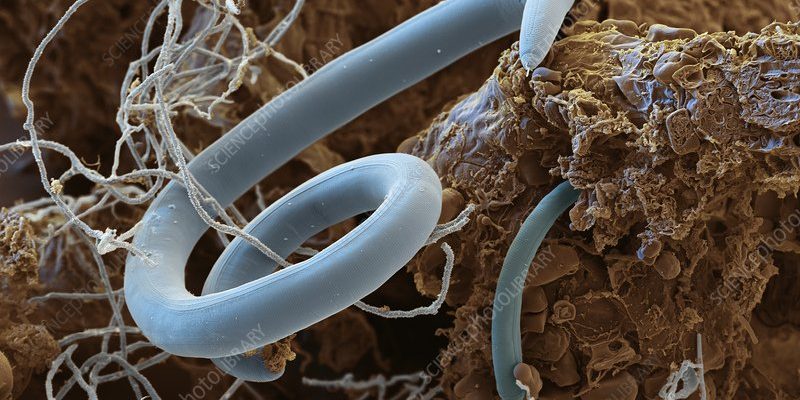
You might be wondering: why should we care about roundworms? Well, just like how a small bicycle chain helps a big bike move smoothly, roundworms help ecosystems function. They interact with various microorganisms and small critters, influencing nutrient cycling, soil health, and even plant growth. Let’s dive into the tiny, yet fascinating, world of roundworms and see how they interact with other microfauna in their ecosystem.
What Are Roundworms?
Roundworms, or nematodes, are among the simplest worms in the animal kingdom. With their long, cylindrical shape and slender bodies, they resemble tiny spaghetti noodles. They can be found in various environments, from freshwater to soil and even in marine ecosystems. They come in many types—some are helpful while others might be parasites.
One of the interesting things about roundworms is their sheer abundance. It’s estimated that a single teaspoon of healthy soil can contain thousands of roundworms. They play a vital role in breaking down organic matter. This process is crucial for maintaining soil health, as it helps recycle nutrients.
In short, the presence of roundworms is a good indicator of a thriving ecosystem. Think of them as the unsung heroes of the soil—working behind the scenes to keep things in balance.
Roundworms and Soil Microfauna
So, how do roundworms fit into the larger picture of soil microfauna? Well, they interact with a variety of microorganisms, including bacteria, fungi, and other small animals. This interaction helps regulate populations within the soil community.
For instance, roundworms feed on bacteria and fungi. By doing this, they help control these populations, preventing any one type from overwhelming the ecosystem. This is crucial because too many bacteria can lead to unhealthy soil conditions, while too few can mean plants don’t get enough nutrients.
Additionally, when roundworms break down organic matter, they release nutrients back into the soil. This process enriches the environment, making it more hospitable for plants and other microorganisms. It’s a bit like how compost enriches garden soil—roundworms are nature’s composters, enhancing soil fertility and health.
Interactions with Other Invertebrates
Roundworms don’t just work solo; they interact with other soil invertebrates, such as mites, springtails, and earthworms. Each of these creatures has a role to play, and together they create a dynamic ecosystem.
For example, as roundworms consume bacteria and fungi, they also provide food for larger soil invertebrates. Mites and springtails often feed on roundworms, taking advantage of their presence in the soil. This interplay helps maintain balanced populations within the ecosystem, ensuring that no single species dominates.
Moreover, earthworms and nematodes can have a mutually beneficial relationship. Earthworms aerate the soil and create channels that improve drainage. This, in turn, helps roundworms thrive in their environment. It’s like a team sport where everyone helps each other succeed.
The Role of Roundworms in Nutrient Cycling
Nutrient cycling is a fundamental process in any ecosystem, and roundworms play a crucial part in it. They participate in breaking down organic matter, which releases essential nutrients like nitrogen and phosphorus back into the soil. This is especially important for plant growth and overall ecosystem health.
When roundworms feed, they don’t just consume; they also excrete waste that is rich in nutrients. This waste becomes a natural fertilizer for the soil, promoting plant growth and supporting other microorganisms. Think of it like a natural recycling system where nothing goes to waste.
By helping to recycle nutrients, roundworms also facilitate the decomposition process. They are part of the larger community that breaks down dead plants and animals, ensuring that energy flows through the ecosystem effectively. Without this function, ecosystems could struggle to maintain the balance needed for life.
Impact on Plant Health
You might not think about tiny roundworms when you consider plant health, but they’re actually quite significant. Their interactions with soil microfauna can influence plant growth and productivity. Healthy soil leads to healthy plants, and roundworms are integral to that soil health.
For instance, by breaking down organic matter and releasing nutrients, roundworms make essential elements available for plants to absorb. This means plants can grow bigger and stronger, producing better yields.
Moreover, some studies suggest that the presence of certain roundworm species can even help plants defend against pests. It’s like having a friendly neighbor who offers to watch your house while you’re away. These roundworms create a supportive environment where plants can thrive.
Challenges and Threats to Roundworms
Despite their importance, roundworms face various challenges that can impact their populations and, consequently, the ecosystems they help sustain. Environmental changes, pollution, and habitat destruction can have detrimental effects on their numbers.
For example, excessive use of pesticides can harm roundworm populations, disrupting the balance in the soil ecosystem. Without these little guys, the entire soil community can suffer, leading to poorer soil health and reduced plant growth.
Additionally, climate change can alter the habitats that roundworms depend on. Changes in temperature and moisture levels can affect their survival and reproduction rates. Addressing these challenges is crucial for maintaining healthy ecosystems.
The Future of Roundworms in Ecosystems
Looking ahead, it’s clear that roundworms will continue to play a vital role in ecosystems. As we learn more about their interactions with microfauna and their importance in nutrient cycling, we can better appreciate how they fit into the larger tapestry of life.
Conservation efforts that support soil health and biodiversity are essential for protecting roundworm populations. By understanding their significance, we can promote practices that ensure these tiny creatures thrive.
In conclusion, roundworms might be small, but their impact is enormous. They interact with other microfauna to maintain balance, promote nutrient cycling, and support plant health. As we navigate the challenges of a changing world, let’s remember to value the little heroes that keep our ecosystems thriving.

